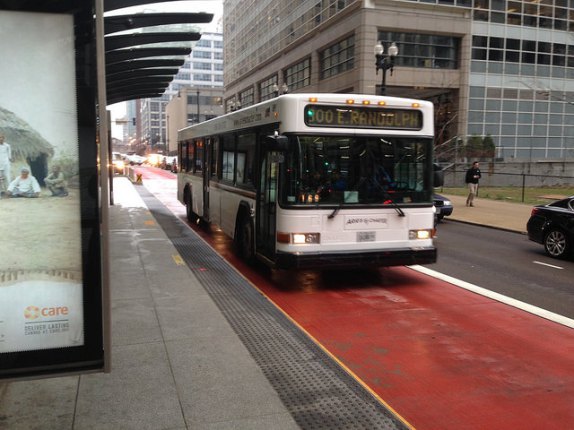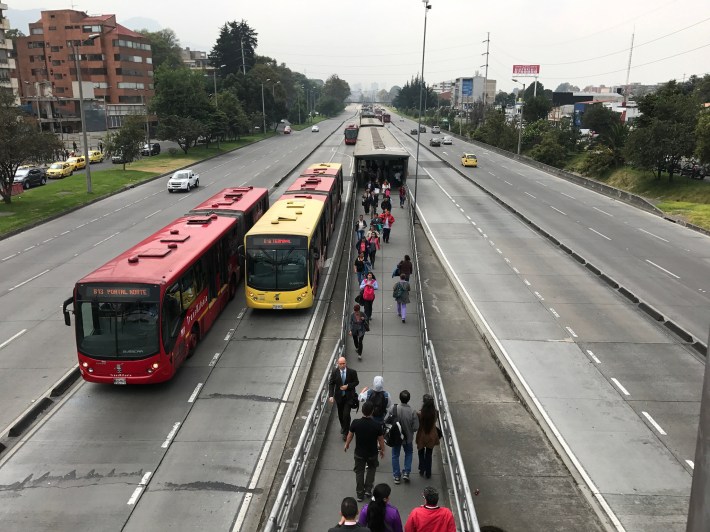So far the Loop Link bus rapid transit system’s timesaving features, including dedicated bus lanes, near-level boarding platforms, a reduced number of stops, and special signals that give CTA buses a head start at some stoplights, appear to be resulting in a modest time savings for commuters.
However, the system still isn’t living up to its full potential because the city has been dragging its feet on implementing prepaid boarding, which was originally supposed to be in effect at all eight of the stations when the system debuted in December 2015. 19 months later CTA has only tested prepaid boarding at the Madison/Dearborn Loop Link station, as well as three other bus stops in various parts of the city, using a system that requires an employee to be present.
Another problem is private vehicles clogging up the Loop Link lanes. Some peer systems, such as New York City’s Select express bus routes, feature camera enforcement of the bus-only lanes. But due to the unpopularity of automated enforcement in Chicago, and a state law requiring the Illinois General Assembly to approve additional traffic camera enforcement in Chicago, we won’t be seeing those anytime soon. Meanwhile, there seems to be little enforcement of the lanes by police officers, which is one reason its common to see non-CTA drivers, especially operators of private commuter shuttles, illegally using the lanes.

Here’s a cheap, fast, effective solution to this problem. When I was in Mexico City and Bogota and Cartagena, Colombia, I observed that the local BRT systems featured low plastic curbs, bolted into the road, to discourage motorists from driving in the bus lanes. (In Mexico City, these plastic curbs are also used to create low-cost curb-protected bike lanes.) Easy-peasy, right?
It’s not that sample, according to Chicago Department of Transportation spokesman Mike Claffey. He said using curbs to keep private vehicles out of the Loop Link lanes is not an option since the bus lanes are not continuous – drivers of private vehicles are allowed to cross the lanes in some locations. In addition, he said that the system was designed to allow some use by private vehicles, including ingress and egress to garages and alleys.
Claffey added that curbs would interfere with snow plowing (which is not an issue in Mexico City or the Colombian cities.) Lastly, he said curbs would inhibit the CTA’s ability to let buses pass one another in the event of a breakdown or to alleviate bus bunching.
The plastic curbs I saw were high enough to discourage drivers of private vehicles from entering the bus lanes, but low enough that it’s possible to drive over them if necessary. And couldn’t most, if not all, of the issues Claffey raised be addressed by having occasional gaps in the curbs? He said he didn’t have a response to this question.
However, the Active Transportation Alliance is encouraging CDOT to look into installing curbs along Loop Link, as well as to implement other strategies to speed up the buses. “The city needs better ways to keep bus lanes clear of automobile traffic, hold violators accountable, and maximize the impact of public investment in bus infrastructure,” said Active Trans director of government relations Kyle Whitehead. “Adding physical separation with curbs is one approach that’s worthy of research and evaluation on Chicago streets.”
Whitehead added that the city should step up manual enforcement of the lanes. “In cities across the U.S. and around the world, it has been proven that targeted in-person enforcement by the police department and other city agencies works. Longterm, a new state law is needed that enables photo enforcement of bus lanes.”
Later this year Active Trans is releasing a bus service report in partnership with the TransitCenter foundation that will highlight low-cost ways to speed up CTA buses, including adding more bus lanes while stepping up enforcement.






